#votive Terracotta face
Text
An excavation in Sicily's Valley of the Temples has unveiled a treasure trove of 60 terracotta statuettes, bronze fragments, and bones from 406 BC. These poignant offerings, left behind after an exodus, serve as a testament to human strength in the face of adversity.
18 notes
·
View notes
Text
Votive Limbs and Their Purpose
C/W: Links to images of ancient depictions inner organs and genitalia are included in this post.
Who is Asklepios? He is the son of Apollo and the Greek god associated with medicine. He had a fair few, well known children; daughters Hygieia (goddess of health, cleanliness, and hygiene), Panacea (goddess of medicine), Iaso (goddess of recuperation from illness), Aceso (goddess of the healing process), Aegle (goddess of good health), and sons Machaon and Podaleirus (medics mentioned in the Iliad). There were temples of healing dedicated to Asklepios in most—if not all—major cities in Ancient Greece. They were set up in a way that is reminiscent of modern clinics—with a room for beds and a room for cleansing for hygiene purposes—and were tended to by the priests of Asklepios (of whom its theorized that Hippocrates was one of).
What exactly are votive limbs? To answer, they are artificial limbs found buried in temples dedicated to Asklepios and are thought to be offerings of thanks for healed body parts or offered up in the hopes that they will be healed. They were made from a variety of materials; primarily terra cotta, stone, and marble. Archaeologists have begun theorizing that the surplus of specific limbs at specific sites indicates that site having a healing specialty. For instance, Athens specialized in feminine health and ocular issues while Corinth (their mortal enemy) specialized in breasts, venereal disease, and limbs. However, it also appears that women’s health specialized temples weren’t as common as they appear and the majority of temples likely treated more men than women.
The practice of using votive limbs was not limited to Greece, with some limbs being found in Etruria. The practice of burying votive limbs likely travelled to this region with Greek traders who had and practiced this belief. They taught the people what to do and the Etruscans picked up the belief, adapting it to their own religion and environment. The Etruscans used the terracotta votives for all their gods, as opposed to the Greeks who used the terra cotta votives almost exclusively in Corinth and a different material everywhere else. They were made with molds and out of terra cotta as a way to make it affordable and as a way of using the materials available to them. They were also painted in ways that may have signified the city they were made in. What is unique to the Etruscan practice is the burying of anatomical reliefs with organs depicted on them. In addition to organs, they also depicted limbs, faces and heads, and sometimes babies.
Overall, the votive limbs appear to be something that was used as a way to communicate with the gods—be it out of thanks or to ask them something. While to us, today, the offerings may be a bit out there they would have made the most perfect of sense when they were first buried. Hopefully, with the discovery of more limbs and offerings we will be able to better understand why exactly they were left for Asklepios.
#ancient culture#ancient greece#ancient history#ancient civilizations#ancient medicine#cool things#C/W: GENITALIA AND ORGANS#history
3 notes
·
View notes
Text

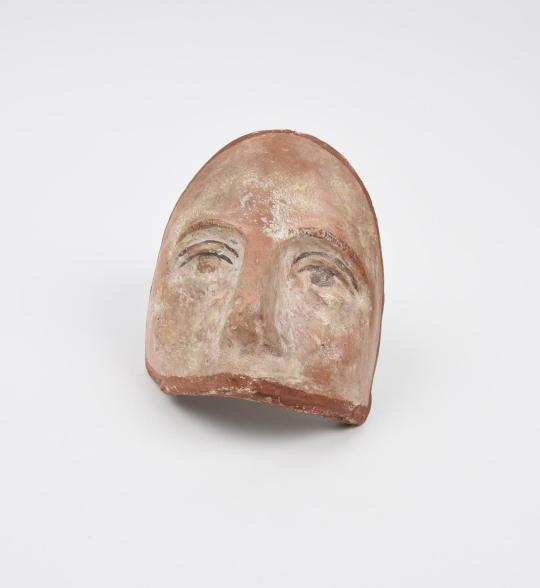
~ Roman votive terracotta face.
Date: 200 B.C.-A.D. 200
Place of origin: Roman Empire
#ancient art#ancient history#ancient roman#ancient#ancient sculpture#history#archaeology#archeology#museum#roman#votive Terracotta face#roman Empire#200 b.c.#a.d. 200#3rd century b.c.#3rd century
184 notes
·
View notes
Text

Beautiful Women of Ancient Medma in Rosarno, Calabria, Italy
Medma, Rosarno? For most travelers to Italy, these names will not ring any bells. The former was an ancient city-state of Greater Greece and the latter is its modern-day counterpart in Calabria. Medma’s terracotta is exceptionally beautiful. You can see a few pieces in the collection of the British Museum, or visit the archeological museums in Rosarno and Reggio, and have your fill.
The terracotta figurines from Medma are particularly striking. The sculptures were fashioned from a local clay that has lent their characteristic reddish color. Medma had close ties with Locri Epizephyrii, a colony established in the 7th century BC by women from Locris in central Greece. Handsome ladies, no doubt.
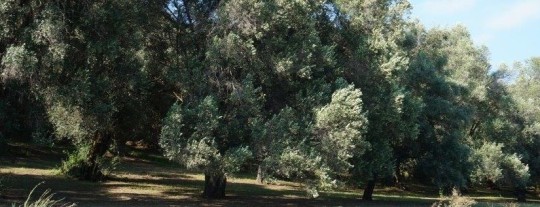
MEDMA HISTORY
The Locrians founded Medma (or Mesma) in the 6th century BC. Locri lies over the mountains along Calabria’s eastern coast on the Ionian Sea and Medma is on the Tyrrhenian Sea on the western shore at what would have been less than a day’s walk back in the day. The present city is called Rosarno and its center sits on a hill overlooking the Gulf of Gioia Tauro. Today, state highway 682 goes west across the peninsula from just north of Locri.
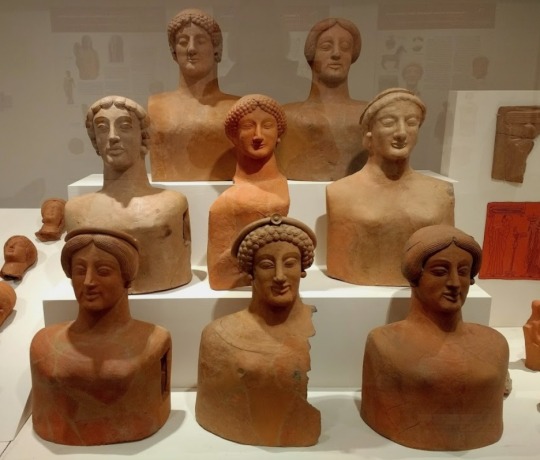
From the dimensions of the excavations of the area, Medma would have been able to accommodate over 4,000 citizens in its heyday during the Greek period. The town was mentioned by Roman writers. However, it is thought that the population eventually moved and founded nearby Nicotera some time in the 2nd century AD.
Excavations have uncovered numerous artifacts as well as structural remains of the city. Judging from the craft of the terracotta and bronze pieces discovered in the necropolis and sanctuary areas, Medma had a distinctive and sophisticated lifestyle with particular emphasis on the exaltation of beauty. Interesting to note that Locri Epizephyrii, the founding city-state, was a matriarchal society that was unique in the Greek world.
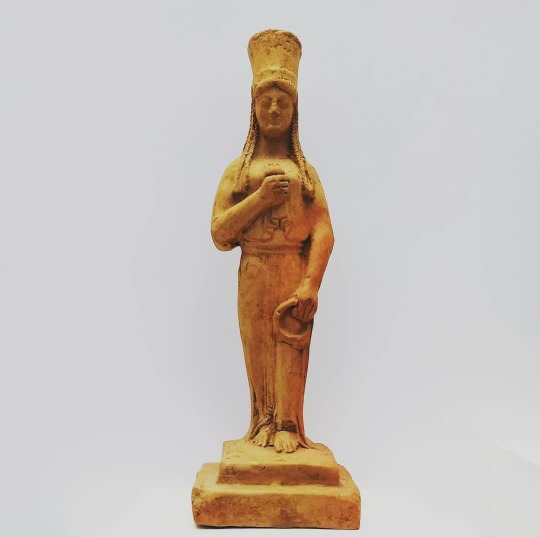
MEDMA’S LADIES
The wealth of terracotta includes many female heads and busts. These votive offerings would have been divine representations or stylized images of the donors, themselves. Various hairstyles frame the noble faces set off by classic earrings or a modest crown. What are they all thinking behind those half smiles?
The enigmatic expressions date these sculptures between the late 6th to the 5th century BC. The following terracotta figures with a rigid, frontal stance, one seated on a throne and the other standing, offer winged creatures that bring to mind the cults of Aphrodite and Persephone.

Another standing female figure from the Archaic Period balances the high cylindrical head covering of a goddess with a wreath in her left hand and a pomegranate, the symbol of fertility, in her right.
MEDMA ARCHEOLOGICAL MUSEUM IN ROSARNO
Numerous ancient objects from Medma are on display in the archeological museum in Reggio Calabria, and in 2014 the Museo Archeologico Nazionale di Medma-Rosarno opened in the city of Rosarno, which is in the Province of Reggio Calabria less than an hour’s drive north of Reggio. More information can be found on the Museo Medma’s Facebook page.
Written by Karen Haid
Follow us on Instagram, @calabria_mediterranea

#rosarno#calabria#italy#italia#south italy#southern italy#mediterranean#ancient#history#art#art history#greek#ancient greece#magna grecia#magna graecia#greek art#olive#olive trees#olive tree#medma#locri#sculptures#sculpture#aphrodite#persephone#archaeology#archeology#women#mediterranean sea#landscape
125 notes
·
View notes
Text

Etruscan Votive (Gift) in the Shape of a Woman’s Head from Veii 500 BCE, terracotta. 26.5 × 22 × 18 cm (10 1/2 × 8 1/2 × 7 1/4 in.). Art Institute of Chicago.
"Supplicants placed votive heads in temples to accompany requests and offerings of thanks to the Gods. Artisans used molds to produce images of both men and women. On finer examples, such as this head, a pointed tool was used to refine elements of the face and hair before the object was fired in the kiln. Traces of pigment suggest that the hair was originally painted bright red. Earrings once hung from holes in the ears."
-taken from artic.edu
https://paganimagevault.blogspot.com/2020/03/etruscan-votive-gift-in-shape-of-womans.html
#etruscan#rasenna#european art#europe#pagan#antiquities#classical art#antiquity#paganism#sculpture#italy#statue#art#art institute chicago#6th century bce
16 notes
·
View notes
Photo

Half-Head of a Goddess (probably), ca. 100-50 B.C.E, Brooklyn Museum: Egyptian, Classical, Ancient Near Eastern Art
Terracotta half-head probably of a goddess. Hair held in place by diadem or band with strands falling down on neck. Idealized features with furrows around nostril. Flat back with circular opening for suspension, open base. Heavy walls. Probably intended as a votive offering. Condition: Slight chips on front and back of base. Lime deposits (from plant growth) on forehead, face and hair.
Size: 11 1/8 × 7 1/2 × 3 9/16 in. (28.2 × 19 × 9 cm)
Medium: Terracotta
https://www.brooklynmuseum.org/opencollection/objects/80385
4 notes
·
View notes
Photo
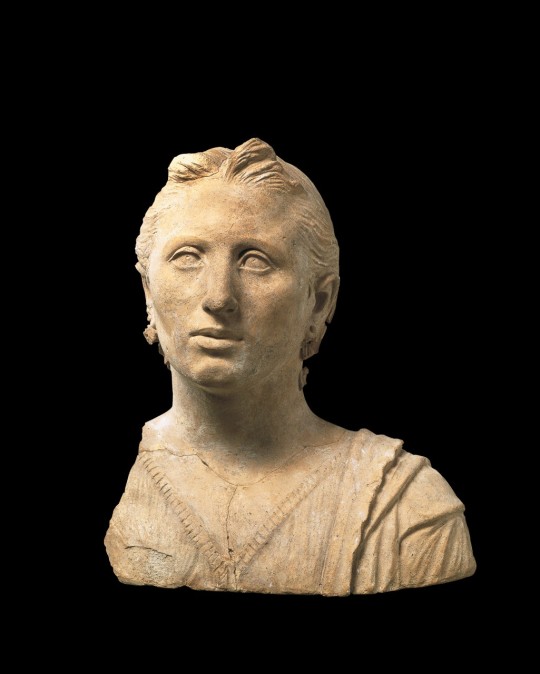
Bust of a woman. Cerveteri, 300 - 250 B.C., terracotta. Gregorian Etruscan Museum.
“The bust is not among the votive terracottas produced in series using moulds, but instead constitutes an original work modelled directly by a capable artist for a high-ranking commission. It depicts a relatively young women with well defined features and is clearly intended as a portrait. The surface of the face and neck is very smooth in order to render the luminosity of the complexion. The lines defined on the neck and below the chin indicate the passing of time on a face that appears to be lost in thought rather than ideally detached. The lion’s-head earrings, which reproduce exemplars in gold found throughout the Etruscan area and in Magna Graecia (around 325 – 200 B.C.) along with the voluminous hair inspired by portraits of Alexander the Great would enable it to be dated from the early Hellenistic period. Mid-Italic portraiture is in part indebted to the formal conquests of Greek art, which during the height of the Hellenistic age developed the first dynastic portraits. Portraiture is a genre that is well attested to in Italic culture, adopted both in the votive and funerary areas, and was subsequently taken up by the Roman aristocracies due to the importance attached to the individual image. The genre passed via Roman art into western figurative culture.” (x)
[id: photo of the terracotta bust described above, which depicts a woman gazing into the distance. end id]
#3rd c#portraiture#terracotta#tagamemnon#classics#etruscans#etruscan art#who is she! i would like to be her friend
76 notes
·
View notes
Text

This post is based on my knowledge of traditions of the north and center mainland of Greece. However, I am pretty sure most of those things apply to Greek Orthodox people universally. Needless to say, each village and town can has its own local traditions when it comes to religious occasions.
I am a Greek Orthodox living in Greece, raised into the religion.
I will translate some phrases directly, hoping to give a more “raw” meaning.
If you are not sure you understood about certain information in the post, feel free to ask me on Tumblr!
Google Drive Link for the post in .docx format
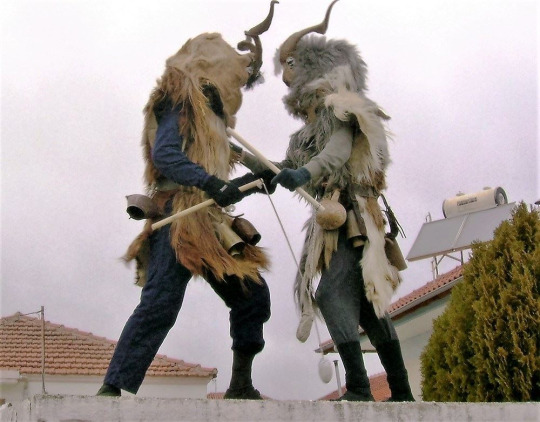
Table of Contents
Philosophy.
The Church as a building and as a center of faith.
Chapels and even smaller churches.
The Communion.
Livanisma / Thimiama – Incense burning.
Home Altars.
Clothing.
Komboskini - The prayer rope.
Tama - Votive
Crosses in high places.
Wedding
Baptism
Wedding & Baptism.
Burial customs and honoring the dead.
Agiasmos - Blessing.
Protomaya.
Martis - The protective bracelet of Spring.
Easter Traditions.
Vasilopita on Christmas
Kalanda
Mount Athos
Pilgrimage to Tinos
The Catching of the Cross
More customs
Random Information
1. Philosophy
Love and Forgiveness are the main pillars of the faith. Some people follow the Bible to the letter, others pick the parts that think reflect our age and most of people keep the general message of the teachings. The Holy Texts are interpreted differently by different people and there can be contradictions in lifestyles and believes. However, the notion that having love and forgiving is what makes you a Christian is widely believed.
Anyone who does not love does not know God, because God is love. - 1 John 4:8
Love is patient, love is kind. It does not envy, it does not boast, it is not proud. It does not dishonor others, it is not self-seeking, it is not easily angered, it keeps no record of wrongs.- 1 Corinthians 13:4-5
There is no fear in love, but perfect love casts out fear. For fear has to do with punishment, and whoever fears has not been perfected in love. - 1 John 4:18
Don’t say ‘I am hated, and that’s why I do not love‘. For this is why you out to love the most. - Ioannis Chrysostomos
“But I say to you who hear, Love your enemies, do good to those who hate you” Luke 6:27
“Do not judge, and you will not be judged. Do not condemn, and you will not be condemned. Forgive, and you will be forgiven.” - Luke 6:37
"Then Peter came to Jesus and asked, 'Lord, how many times shall I forgive my brother or sister who sins against me? Up to seven times?' Jesus answered, 'I tell you, not seven times, but seventy-seven times.' " - Matthew 18:21-22
2. The Church as a building and as a center of faith
Jesus and the Apostles gave us some directions for the worship but most of practices, as well as the architecture of worship came from the Greeks themselves. I jokingly say that Greeks are low key pagans, because religion didn't change the culture. (It did, but only a bit).
Christians first worshipped inside the old temples of the Hellenic gods (the Parthenon was once the temple of Virgin Mary) and they built their first churches in that style. The architecture changed with time but it still carries the mark of ancient temples.
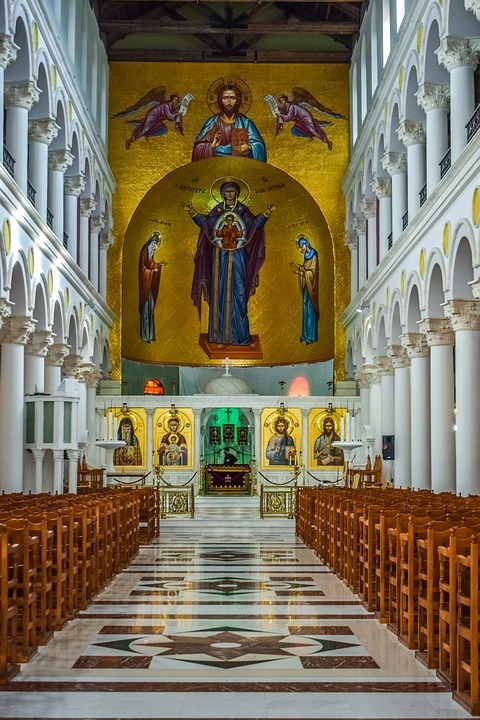
Agios Demetrios Thessalonikis
In this link you can view the different styles of architecture for Greek Orthodox Churches. (Link)
In Orthodox churches you don't have to have a feeling of the dominance of God, like in the Catholic or protestant churches, but a feeling of warmth and belonging.
In the hall you can buy a candle to light on a display of candles in the hall, to get a blessing for yourself and the soul of anyone you want. Nobody supervises you there.


You can also not pay but I haven't seen anyone not giving money, so far.
After that you kiss all the icons displayed in the hall and cross yourself.
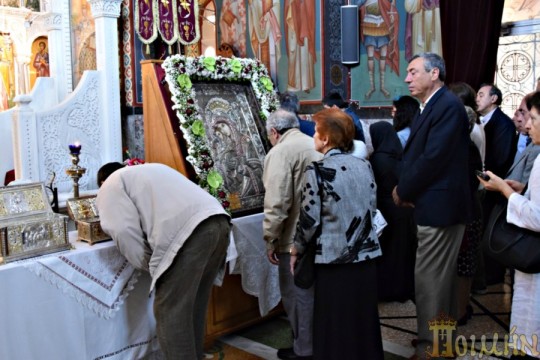
As you enter church, men on the left side, women on the right. There is also a special place for women, an interior balcony which is really cool and women go there if they want to. Nowadays man and women can go there.

3. Chapels and even smaller churches
Chapels serve the same purpose as churches but liturgies rarely happen in them. You can get married in them sometimes.
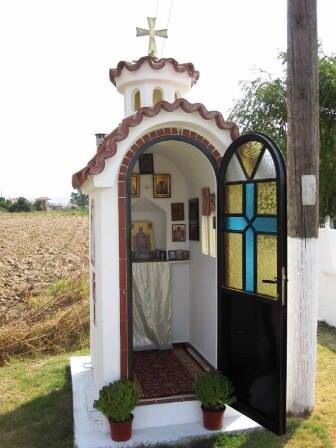
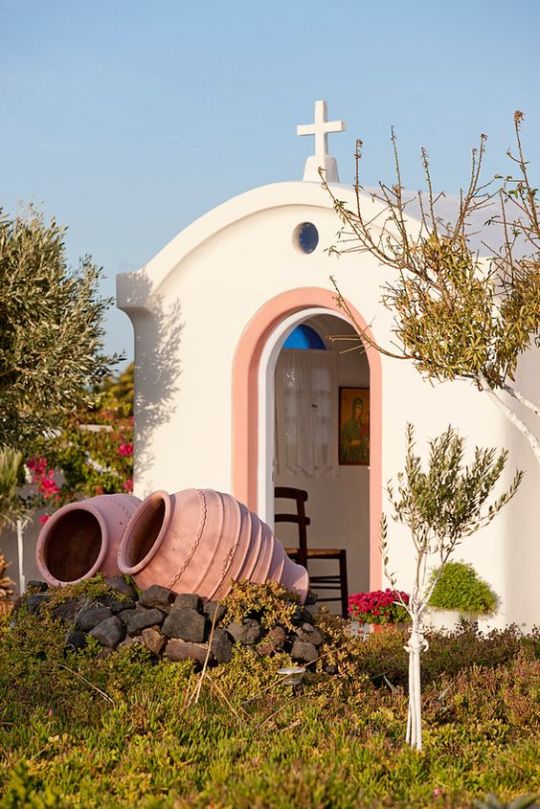
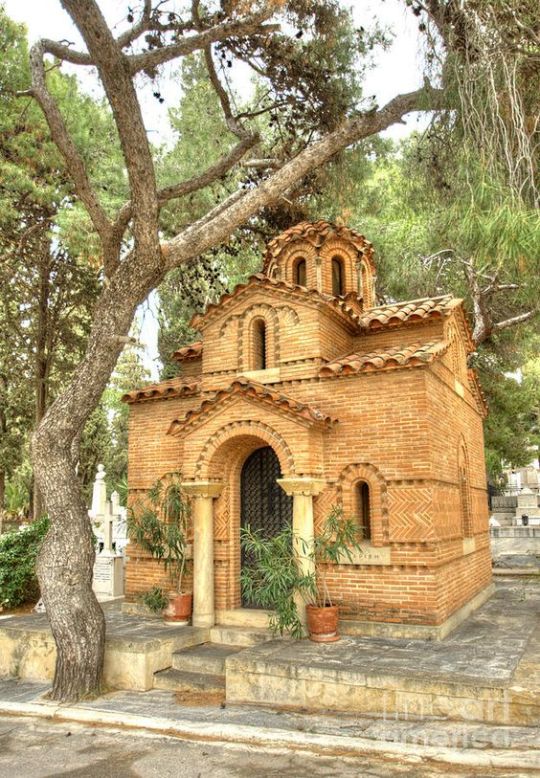
They can be carved in stone or into a cave - even in a tree or in between multiple trees.

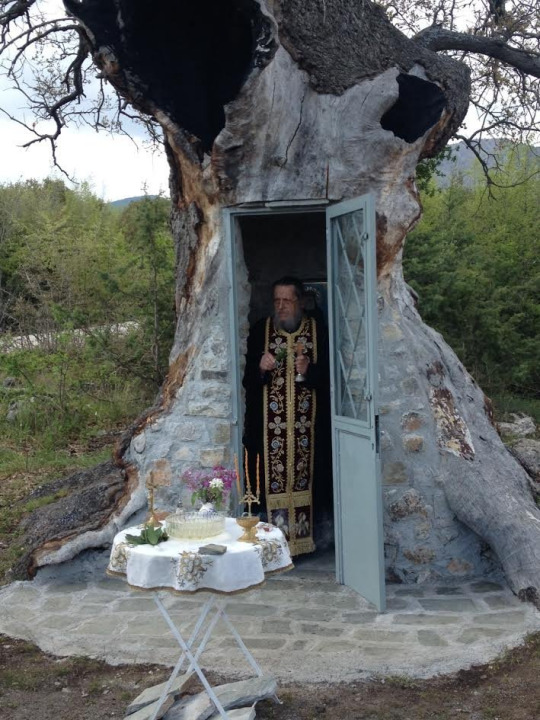


The also exist in big hospitals to bless the patients and invite people to pray for their sick.
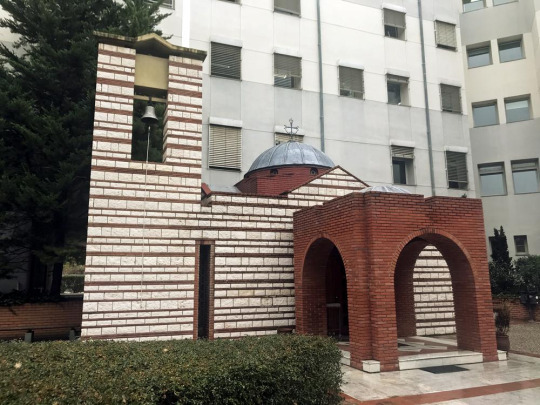

They can be seen in some big hotels, too!
But the churches can become even smaller!

Traveling the roads of Greece you will see dollhouse-sized roadside chapels. Some are elaborate little things made of terracotta or even marble, plonked in the middle of nowhere, high up in the mountains; no village or houses for miles, and yet impossibly, most of them are faithfully maintained with a candle always burning inside.
There’s a number of reasons for these heartfelt shrines, some as old as the roads themselves. Placed by the roadside, an initial assumption is that they’re built to remember a victim of a traffic accident victim, and sometimes this is exactly the case. But just as often, shrines will be built by survivors of accidents, thanking a saint at the location of their ordeal.
They can be found in home yards of people who want to come closer to God
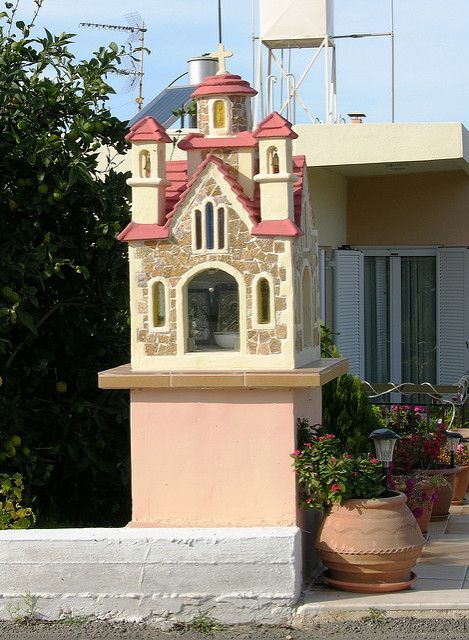
4. The Communion
We all take part in Communion with the same spoon. The Communion has bread crumbs in. Even babies drink a tiny bit of the wine (blood of Christ). Traditionally you were "unpure" if you had your period - others believed the blood of Christ would come out of you as period blood if you drunk it, so generally getting the communion during your period is a no for many.

5. Livanisma / Thimiama – Incense burning

Today, Orthodox Christians use incense throughout the church services. The priest “censes” certain areas at certain parts of the liturgy. The incense is placed inside a device known as a “censor”, which is fairly ornate in appearance and has bells on it so that we not only smell the fragrance, but hear the jingling sound as the priest uses it. This action is meant to remind us that are prayers are rising to the heavens to be heard by God.

Typically in the Orthodox Church, dried incense cones are used. In order to provide the heat needed to allow the cones to burn, a special type of charcoal is used. You also may burn resin, such as Frankincense or Myrrh, directly in an incense burner using charcoal without taking the extra step of mixing it with a binding agent.
Churches often get their incense from special suppliers and maybe even monasteries where the monks or nuns make their own. Typical scents that are used include Frankincense, Myrrh, and Rose.
The believers can also burn incense in their homes and say prayers to ward of Evil.
6. Home Altars
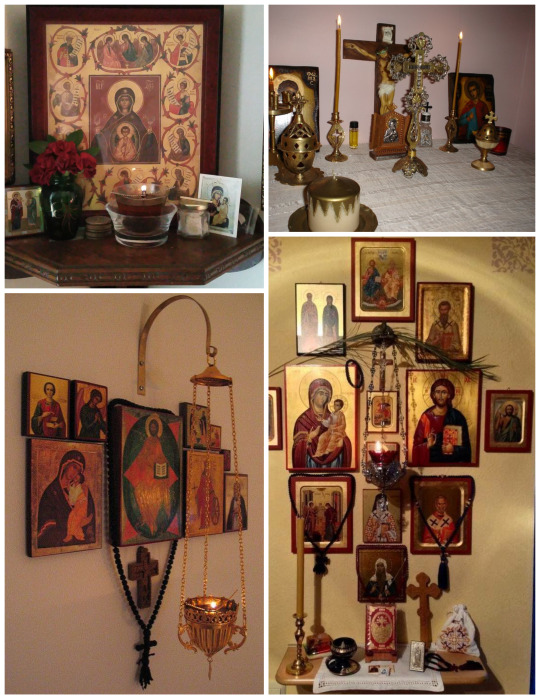
An Orthodox Christian is expected to pray (to be connected with God) constantly. According to Bishop Kallistos Ware, "In Orthodox spirituality, [there is] no separation between liturgy and private devotion." Thus the house, just like the Temple (church building), is considered to be a consecrated place, and the center of worship in the house is the icon corner.
An icon corner is normally oriented to face east. It is often located in a corner to eliminate worldly distractions and allow prayer to be more concentrated. Here is where the icons that the family owns should be located, normally including at least icons of Christ, the Virgin Mary, and the Patron Saint(s) of the family.

An oil lamp normally hangs in front of the icons. The careful trimming of the lamp to keep it burning at all times is interpreted as symbolic of the attentive daily care faithful Christians should take over their souls. Relics of saints (if the family possesses any) and a Gospel Book and a blessing cross would be kept there, as well as incense, holy water, palms and pussywillow from Palm Sunday, candles from Pascha (Easter), and other sacred items, as well as a personal Commemoration Book (containing the names of family and loved ones, both living and departed, to be remembered in prayer).
7. Clothing
People should enter the church in modest attire. No shorts and no short skirts. Women don’t need to cover their head. In fact, almost no woman under 80 covers her head in church.
With special occasions being the exception, Greek Orthodox Priests wear a black himation because of the fall of Constantinople. They wear it all the time, even to grocery shopping. They have long hair and beard.
In rare cases you will see women dressed with a long black cloth - something like a burqa but the whole face is uncovered. They are nuns or devoted to Christ.
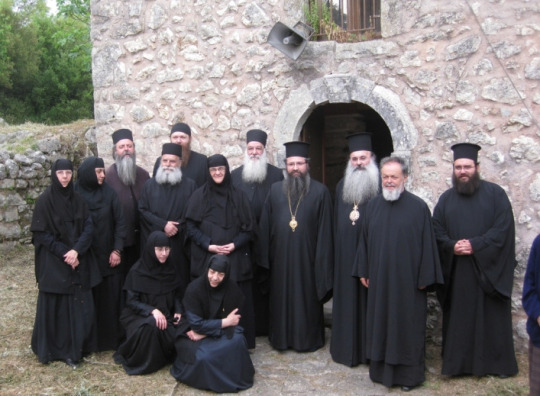
8. Komboskini - The prayer rope
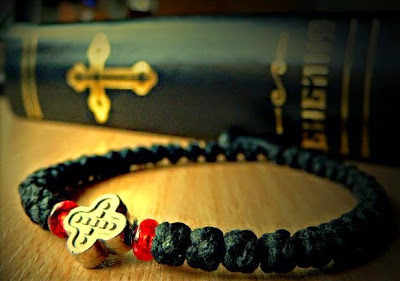
The prayer rope, known in Greek as a κομποσκίνι (komboskini), has long been a powerful weapon for the Orthodox Christian. It has a very simple design, but is filled with meaning. The rope typically comes in one of three lengths, 33 knots, 50 knots, or 100 knots, though there are some in use which are as long as 500 knots. The 33 knots of the shorter rope symbolize the 33 years Christ spent on earth.
It is used in conjunction with the Prayer of the Heart. On each knot is said, "Lord Jesus Christ, Son of God, have mercy on me, a sinner." This prayer is occasionally shortened to, "Lord Jesus Christ, have mercy on me," and other prayers are sometimes said, such as, "God be merciful to me a sinner." Prostrations can also be made with each prayer or after a certain number of prayers. By carrying a prayer rope on us discreetly, we are reminded to “pray without ceasing”.

The prayer rope is attributed to St. Pachomius (4th century). The devil would untie the simple knots he would make to count his prayers. Inspired by a vision from an angel of God, St. Pachomius was able to create a special knot composed of nine interconnected crosses (representing the nine angelic classes), that the devil was unable to untie.
9. Tama - Votive
Tama is a form of votive offering or ex-voto used in the Eastern Orthodox Churches, particularly the Greek Orthodox Church. Tamata are usually small metal plaques, which may be of base or precious metal, usually with an embossed image symbolizing the subject of prayer for which the plaque is offered.

The tradition comes from the ancient years, when Greeks offered metal or marble plaques to the gods, often for the cure of an ailment. Eyes may indicate an eye affliction, hands or legs may indicate maladies of the limbs, a pair of wedding crowns may mean a prayer for a happy marriage, etc.
Tama also means Promise. Usually the believers promise something to a saint in exchange for their help on something. My aunt made a tama to the saint Anastasia Farmakolitra ("saves through medicine") to change her name day from the day of the Resurrection to the day of Anastasia Farmakolitra's day if her daughter passed to Pharmaceutical School. Many promise to light big candles (Lambathes) as an offering to the saint or make a donation to their church. Making a lambatha in your height is a standard tama.
10. Crosses in high places
The Greeks want to feel watched over by the Divine but also leave their mark in the area they live. A way to show their devotion is to place big crosses in hills and mountains which overlook their city, town or village.
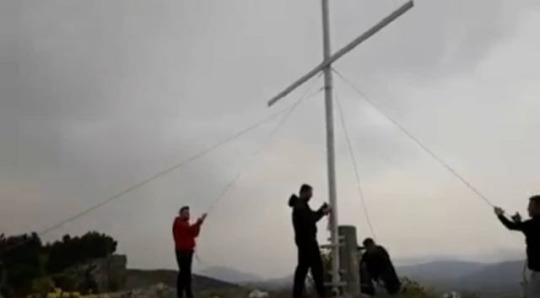
In some cases you find those crosses in high, remote places.

Some crosses light up at night!

11. Wedding
When the priest says "and the woman should fear the man" in a wedding, the bride may step on the groom's foot to show dominance.
In the bride’s shoe sole her unmarried friends write their names. The woman whose name fades first will be the first to marry
The relatives also put money into the shoe of the bride “so it can fit better“ - but really it’s just a gesture to give money to the couple
The Crowning is the highlight and focal point of the Sacrament of Holy matrimony. The priest then takes two wedding crowns (stefana), and blesses the bride and groom in the name of the Father, and the Son, and the Holy Spirit, and then places the crowns upon their heads. The Best Man or Best Woman then interchanges the crowns three times as a witness to the sealing of the union. People keep their stefana in their house and even frame them.

12. Baptism
Greeks take their names from their grandparents (since ancient years) and the name is kept a secret until the baptism.
It is a ceremonial moment because prior to the Christening, the individual is not yet part of the church family. In the church hall the priest asks the person to be christened to renounce Satan. If the individual is an infant, the godparent does it for the child. In the next major part of the ceremony, the person being baptized is immersed in the water three times, which is symbolic of Christ’s birth, death, and resurrection. The person is oiled - so they can be blessed and slip from the hands of Satan - and a tuft from their head is cut - to symbolize new beginnings, devotion to Christ and to give Satan less hair to grab them from. If baptized as an infant, after immersion the child is placed in the arms of the godparent with a white sheet, which symbolizes purity. Then, the child receives the sacrament of Chrismation.
The godparent gifts a golden cross to the baptized and, as long as the baptized is young, they buy them shoes for Christmas and an Easter Candle for Easter.

13. Wedding & Baptism
You can do a wedding-baptism to save money. First the marriage, then the baptism. If the child is about to die before a baptism gets arranged - God forbid - they get baptized in the air (and not in water) by a priest.
Koufeta (Sugar Coated Almonds) are mainly served in weddings but also when wedding and baptism happen in the same day. They are placed in little bags in odd numbers and are served on a silver tray. Odd numbers are indivisible, symbolizing how the newlyweds will share everything and remain undivided. Tradition holds that if an unmarried woman puts the almonds under her pillow, she'll dream of her future husband.
After wedding and/or baptism there is - of course - a feast with hundreds of guests.

14. Burial customs and honoring the dead
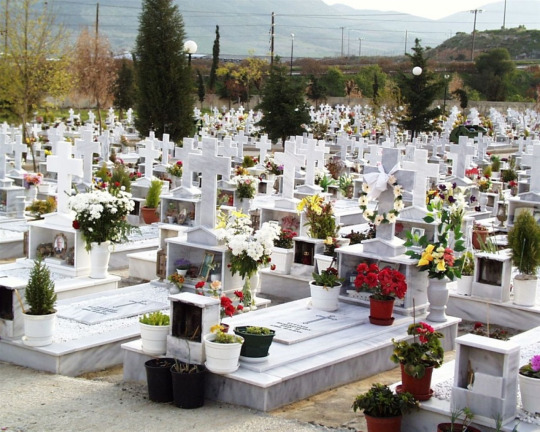
Pouring wine on the graves during the burial, as an offering or to prevent the dead from coming to life. (I am not sure but that is probably wine blessed in the church).
There is a feast after every mystery. Even funerals.There are more feasts for the dead as time passes. You have to do them in 3 days, 9 days and 40 days. You don't have to do all of them but it's showing respect to the dead and most people do them. 3 and 40 days feast are very important. For the 40 days feast - as for the funeral - there are flyers on the area, which invite people.
When 1 year and 3 years pass you go to Church and the priest mentions the name of the dead in the blessings and later comes from the grave to chant.
During the Sabbath of Souls you have to bring koliva (wheat) to offer to the dead in the family. Supposedly the dead "feed" from them. So it has to be boiled!
Charon is the one who takes souls in our recent tradition.
Graves stones often have sketched pictures or photos of the deceased on them.
15. Agiasmos - Blessing
The start of the New Year in the tradition of the Orthodox Church is marked with the blessing of homes and businesses with Holy Water, or an Agiasmos (literally, to make blessed). This practice commences immediately following the Feast of the Theophany (the annual celebration and remembrance of the Baptism of Jesus Christ – January 6). This blessing is not something done for good luck or to prevent bad luck, but rather a blessing to help strengthen and protect.
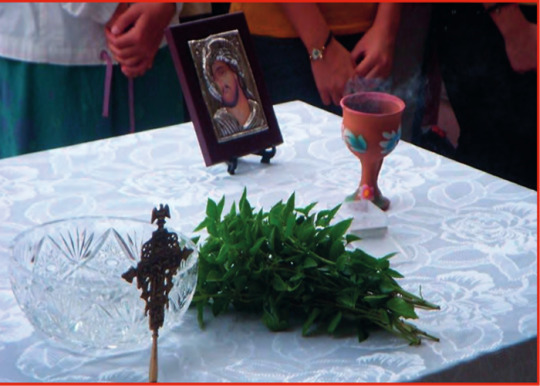
The following items are needed for the ceremony:
Small or medium size bowl, filled halfway with cold tap water
Small twig of fresh basil (floral kind)
Icon displayed behind the bowl
Hand censer, lit and burning incense during the service
The service is also provided in schools when the new school year starts. This is a particular occasion which can be annoying but also fun for the students because... water shower! Please watch this video (Link). I love it because the priest comes too close to the children - sometimes they want to bless too much - and the kids try to avoid getting wet from head to toe!
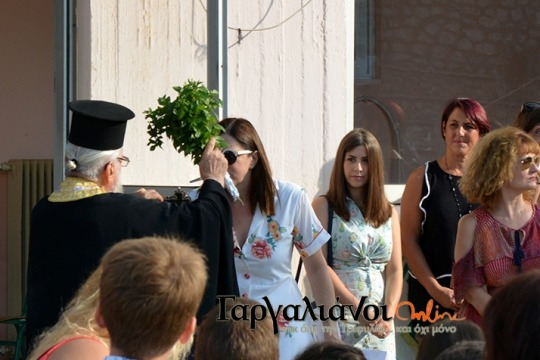
16. Protomaya
May, according to Greek folklore, has two meanings: The good and the bad, rebirth and death. The custom celebrates the final victory of the summer against winter as the victory of the life against death go back at the ancient years and accumulated at the first day of May. This day was also dedicated to the goddess of agriculture Dimitra and her daughter Persephone, who this day emerges from the under world and comes to earth. Her coming to earth from Hades marks the blooming of nature and the birth of summer.
Another ancient celebration that Protomagia has its roots is Anthestiria, a celebration in honor of Dionysos (the Greek God of theater and parties) a festival of souls, plants and flowers, celebrating the rebirth of man and nature.
The custom of May 1st is to decorate the doors of houses with flower wreaths in a way to welcome the power of nature into our home. The wreath is made from various flowers, handpicked and knitted together. In some parts of Asia Minor, people put on each wreath, except flowers, a garlic for the evil eye, a thorn to protect the house from enemies and an ear for good harvest. The wreaths adorn the doors of the houses until the day of St. John the Harvester (June 24) when all the wreaths of the neighborhood are gathered and burnt in a big fire, the fire of the saint.
See my hashtag #protomaya for more
17. Martis - The protective bracelet of Spring

It’s said it’s an ancient tradition dating back to the cults of Demeter and Persephone. Eleusis was the ancient city where the ancients performed secret rites for the cult. As a form of initiation into the cult, which was one of the Eleusinian Mysteries, the faithful wore a bracelet called a “kroki” around both their right hand and left ankle. Amazingly, the ancient tradition still lives on today in modern Greece. However, there are certain rules that one must abide by when creating and wearing the symbolic bracelet which celebrates the arrival of Spring.
Most importantly, the bracelet must be woven on the last day of February and it must be made of white and red thread. The white thread of the bracelet symbolizes purity while the red represents life and passion.
In ancient times, people believed that the bracelet helped protect the person who was wearing it from diseases, as well as the strong rays of the spring sun during the month of March. Today they say it protects from the strong rays but also the cold of March. Since it’s a transitional month you can burn from the sunrays but you also need wood for your fireplace!
Part of the ancient tradition in Greece calls for the person wearing their red and white “Martis” bracelet to take it off and tie it to the first flowering tree they see in March, in order to yield a healthy harvest and to keep the tree healthy.
Another practice with Martis bracelets occurs when the first swallow of the Spring is sighted. The first person who sees a swallow upon the bird’s return from its winter migration, ties their bracelet around the nearest rose bush to encourage the bird to make its nest there.

18. Easter Traditions
Easter is the biggest celebration of the Greek Orthodox tradition. The Holy Week, preceding Easter Sunday, is a time to ponder on Jesus’ Passion and Crucifixion. It is often regarded as an opportunity for body cleansing through fasting, visiting their town of origin and embracing local traditions.
We fast for 40 days (cutting more and more foods every week). Before the fasting we have Tsiknopempti when we eat as much meat as we want, to give our body what it needs before cutting it for 40 days. (It's sort of a celebration and people go out). University restaurants and private restaurants always have fasting options this period. The first day of the fasting is called Clean Monday and it's also like a celebration. It’s the first day we start eating “fasting” food and we also fly kites!
Kyra Sarakosti - Lady Lent

She can be made out of paper or dough. Lady Lent has seven feet. They represent the seven weeks of Lent. Each passing week, on each Saturday, children get to break off one foot. This is a great visual way to countdown the weeks until Easter.
Lady Lent has no mouth. The missing mouth symbolizes fasting. No consumption of meat, dairy products or eggs. She has no ears, this means that she refuses to listen to gossip. Her cross represents the easter religious services in the church, her hands are folded for prayer.
After the last foot is cut off, it is tradition to place this foot in a bowl with fruits and nuts and whoever finds it receives a special blessing.
You don't have to fast if you don't want to. Fasting from bad thoughts and words is equally - if not more important - than food fasting.
Epitaphios threnos (funerary lamentation) is the name of the matins of Holy Saturday, served in Good Friday evening. Within a liturgical context, this is also the name of an icon, usually made of cloth and richly embroidered, depicting the body of Christ being laid in the grave, often by the Virgin Mary and some disciples.
On Good Friday morning, the icon is placed on a platform, resembling a bier, typically topped with an elaborately carved wood canopy. In most cases, the canopy is heavily decorated with ornate flower arrangements, ribbons and sometimes candles. Young girls (the "virgins") have to adorn it with flowers.

Throughout the day, people can come into the church and venerate it. Kids have to pass under the platform in order to take a blessing.
In the evening the service begins; near the end of the ceremony, the canopied platform bearing the icon is lifted on the shoulders of priests or churchgoers (usually four to six people) and carried through the streets followed by the believers.

In towns with more than one parish, the processions starting from different churches may converge to a single spot (usually the town square), where they temporarily stop and a common hymn is sung before they resume their routes. In large towns, the chants are often performed by a marching band.
The epitaphs in the Central Square of Larissa (Short Video)
These practices have numerous variations according to regional traditions. On the island of Zakynthos in the Ionian, instead of an embroidered cloth, a lamb is used: this is a figure of the dead body of Christ, cut out from board and painted from both sides, placed vertically so that it can be seen from either side of the bier. Another famous custom, the “burning of Judas”, where an effigy of Judas is set aflame on a bonfire, is usually regarded as an Easter Sunday ritual; in some parts of Thrace and Macedonia, however, it takes place on Good Friday, after the procession. In some coastal towns, most notably on the islands of Hydra and Tinos, the men carrying the Epitaphios march right into the sea, until they are at least waist-deep in water, where they may remain for several minutes, often holding the platform high to protect it. During this time, prayers are said for the welfare and safe return of the many seafarers coming from those communities.
Watch footage from the Epitaphios procession in Kaminia, Hydra (Short Video Link)
Τhe flowers used for the adorning of the Epitaphios are considered blessed and women used to put them under their pillow for protection or to dream their future husband, or to put them in talismen for their beloved or use them as medicine, or they put them in the home altar.
On 00:01 on Easter Sunday the priests happily chant "Christ has risen from the dead!" in one of the most known and iconic chants in Greek Orthodoxy. There are fireworks and we kiss each other on the cheek having this exchange: - Christ has risen! - True!
This exchange is used by many as a greeting for 40 days after the resurrection.
In the Resurrection the priest offers the Holy Light and people go to get it and pass it to their own company or anyone else who asks for it. The candle is held in candles you buy yourself but for children their god parents buy them.
With the smoke of this fire you make a cross above your door and you don't clean it up - never. A door can have multiple black crosses above it. With the Holy Light you light up the lamps of your home altar.
Some people have breaking eggs contests right after the announcement of the Resurrection, others do them when they come home. We also eat a special soup that night called Magiritsa. It has meat so with this we cut our feast. When the morning comes we host family gatherings and eat as much meat as we want.
19. Vasilopita on Christmas

The Greek word Vasilopita is directly translated as “Sweet Bread of Basil”. When the Vasilopita is prepared, a coin is baked into the ingredients. When the observance begins, usually on New Years Day, the bread is traditionally cut by the senior member of the family, and the individual who receives the portion of the Pita which contains the coin is considered Blessed for the New Year.
Vasilopita is also cut in educational institues and the workplace. Whoever finds the coin usually receives a gift.
This age old tradition commenced in the fourth century, when Saint Basil the Great, who was a bishop, wanted to distribute money to the poor in his Diocese. He wanted to preserve their dignity, so as not to look like charity, he commissioned some women to bake sweetened bread, in which he arranged to place gold coins. Thus the families in cutting the bread to nourish themselves, were pleasantly surprised to find the coins.
20. Kalanda

Caroling (kalanda) has roots in ancient Greece. Children would carry small boats and sing songs honoring Dionysius. In Ancient Greece the children would praise the head of the household. At this time in history they would also gift the head of the household with an olive branch, which signified prosperity. Greek Christmas carols date back to the Byzantine times.
After singing for the household, the children receive money (and sometimes sweets). Before the financial crisis one could gather hundreds of euros from Kalanda.
Children say Kalanda on Christmas Eve, on New Years Eve, on Epiphany Even and Lazaros Sabbath. The songs are different for those four occasions.
21. Mount Athos
Mount Athos is a mountain and peninsula in northeastern Greece and an important centre of Eastern Orthodox monasticism. It is governed as an autonomous polity within the Hellenic Republic. Mount Athos is home to 20 monasteries. It’s commonly referred to as Agion Oros (Άγιον Όρος, 'Holy Mountain').

According to the Athonite tradition, the Virgin Mary was sailing accompanied by St John the Evangelist from Joppa to Cyprus to visit Lazarus. When the ship was blown off course to then-pagan Athos, it was forced to anchor near the port of Klement, close to the present monastery of Iviron. The Virgin walked ashore and, overwhelmed by the wonderful and wild natural beauty of the mountain, she blessed it and asked her Son for it to be her garden. From that moment the mountain was consecrated as the garden of the Mother of God and was out of bounds to all other women.
22. Pilgrimage to Tinos

15 August is a national holiday in Greece and sees a mass departure from the cities to the islands and holiday homes in the mainland. However one island in particular witnesses more activity than most; the island of Tinos. Across Tinos are churches and shrines, the most famous of which is Panagia Evangelistria, the most holy church in Greece which houses the ‘Miraculous Icon of Virgin Mary’. In the Greek Orthodox religion, the Icon is considered to be the protector of all of Greece.
In the Orthodox Church the 15th is ‘Virgin Mary Assumption Day’ where the Virgin is believed to have ascended to heaven. The ritual of travelling to pay homage to such a sacred Icon at this time is highly emotional for Pilgrims, with the Holy Icon in Tinos serving as a main passage between the Virgin and the believers who seek comfort and miracles on their trip.

Often pilgrims crawl to the church from the boats that they arrive on on their hands and knees to show their devotion and pray for compassion, good health and healing. The final part of the pilgrimage often happens in the blazing heat which makes the effort even more momentous.

The atmosphere at and around the Church in the days proceeding the event is sincere and intense. Other pilgrims will arrive at Tinos the night before and sleep in front of the Church to ensure they have the opportunity to see and pray to the Holy Icon.
On the day itself the Holy Icon is carried through the streets of Tinos by members of the Greek army and navy, followed by the Greek Orthodox priests, political figures and the public. The procession leads down to the port when the Icon is stationed on a marble podium and speeches are made. The desire of members of the public to touch the icon often leads to a frenetic atmosphere as pilgrims try to touch the Icon itself. After the procession and speeches the Holy Icon is returned to the Church.
__________________________________________
In the same day Epitaphs of the Virgin Mary are honored and are taken to the streets so everyone can pay their respects.
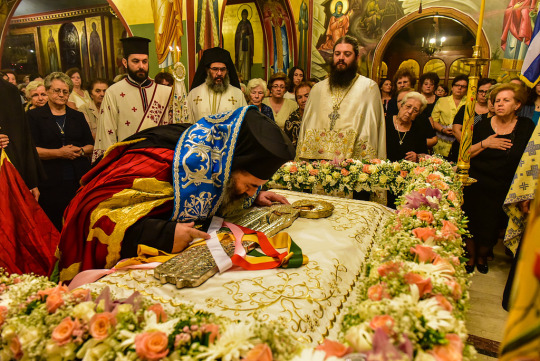

23. The Catching of the Cross
On the sixth of January, the Christmas holidays in Greece officially come to an end with the ‘festival of light’ (‘ton foton’ in Greek), also known as Epiphany.
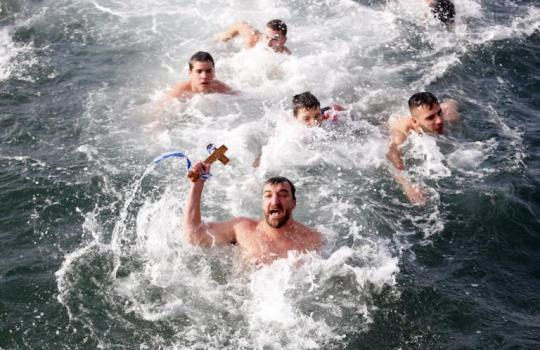
In the Greek Orthodox Church, Epiphany is celebrated as the revelation of Christ as the messiah and second person of the trinity, at his baptism, by John the Baptist, in the River Jordan.
Another cause for celebration in the Greek Orthodox Church on this day is that Christ’s baptism was only one of two occasions when all three persons of the trinity revealed themselves, at the same time, to humanity:
God the Father, speaking from the clouds, God the Son, being baptized in the River Jordan, and God the Holy Spirit, revealed as a dove, descending from heaven.
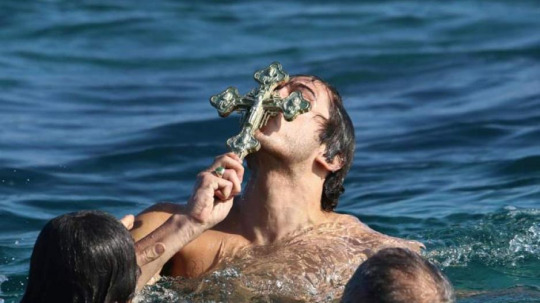
On Epiphany, the Greek Orthodox Church performs
the ‘Great Blessing of the Waters’.
This ceremony is usually performed twice, once on the eve of Epiphany which is performed in the church, and then again on the actual day outdoors with priests blessing large bodies of water, sea, rivers, lakes etc.
The tradition is that
a priest, surrounded by brave young men and boys, throws a cross into the sea, either from the harbour or from a boat at sea; the minute the cross leaves the priest’s hand, the divers jump into the freezing water to catch the cross. The lucky one who finds and returns the cross is blessed by the priest. As the cross is victoriously brought back, the priest releases a white dove, as a symbol of the holy spirit.
This tradition is carried out to commemorate the baptism of Christ and to bless the waters.
24. More customs
Each city, town and village is protected by a different saint. When the saint of the area celebrates a fair is organized. There is music, dance and stalls where the peddlers sell their merchandise.

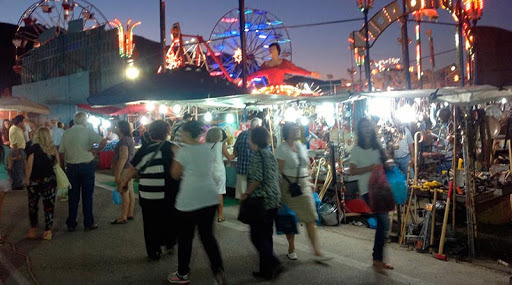
But Greeks know that some of their customs are not approved by the church. We do it anyways and sometimes the priests join, too!
Το celebrate the Epiphany and chase away the evil spirits some residents dress up in scary attire and make a lot of noise with their voice and bells. They drink excessively, they dance and even fight with each other “to the death“ (it’s fake, don’t worry!). This custom exists in many areas of Greece, from Thrace to Cyprus. Even though the people who dress up have many names - momogeroi, babougera, ragoutsia etc - they all symbolize the carefree spirit, childish fun and trickery. Don’t get in their way because they will chase you though the village!

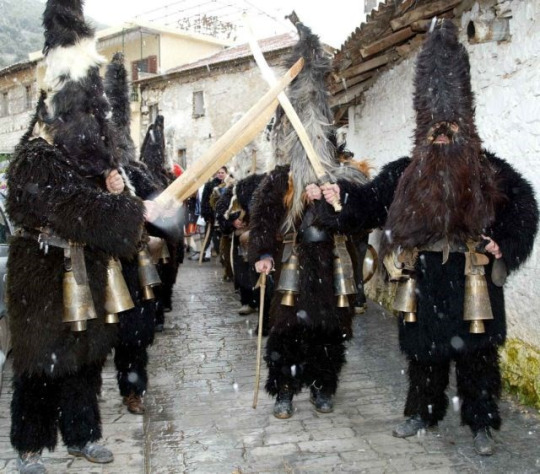
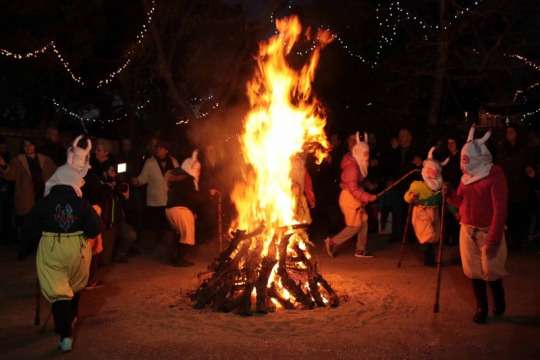
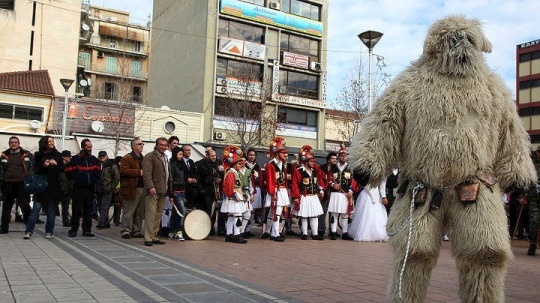
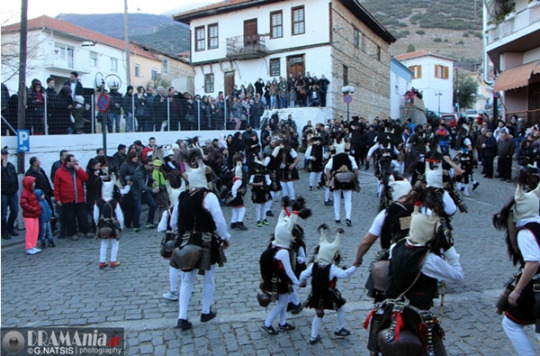

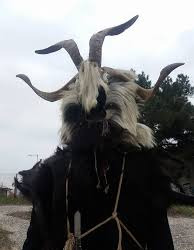
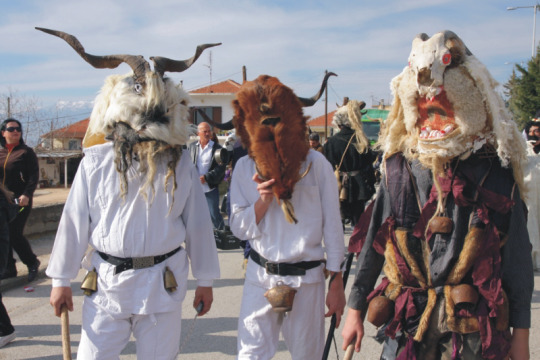

In these festivals there are different characters like the bride, the devil, the cop etc, who can symbolize fertility, the New Year, the Old Year and other concepts.


Sometimes the bride (usually played by a man) is abducted and it’s said to be a remnant of a re-enactment of the abduction of the goddess Persephone by Hades.
In other areas the Dionysiac character of the festival is eccentuated by the presence of a man who pretends ot be the god of wine, vegetation, happiness, Dionysos.

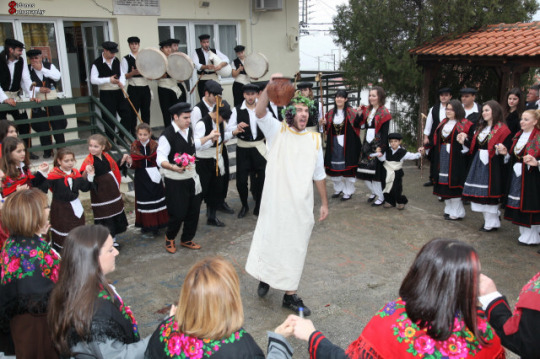
In some areas there is also dancing around a gaitanaki!
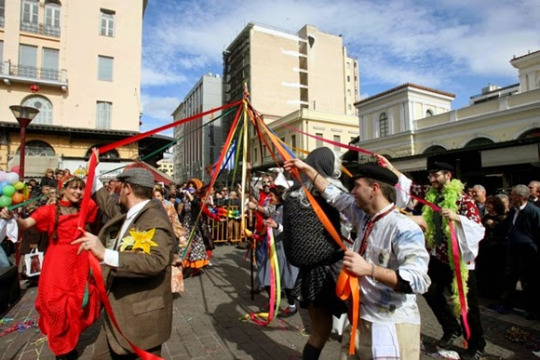
In some areas a fake camel (three people under a cloth) is presented on the streets. It probably started as a spectacle for kids but in some cases today it’s a symbol of resilience and patience. It can also remind us of the magi who rode camels to visit baby Jesus.
There is also the story where a Greek woman is abducted by a Turk and three young men pretend to be a camel to enter the Turk’s wedding with her and steal her back! (Something like the Trojan Horse!)

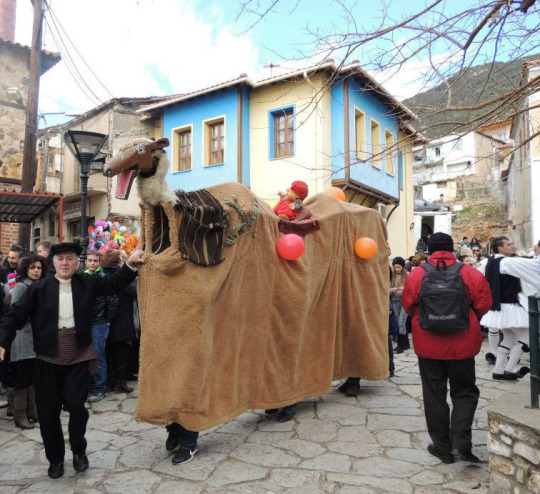
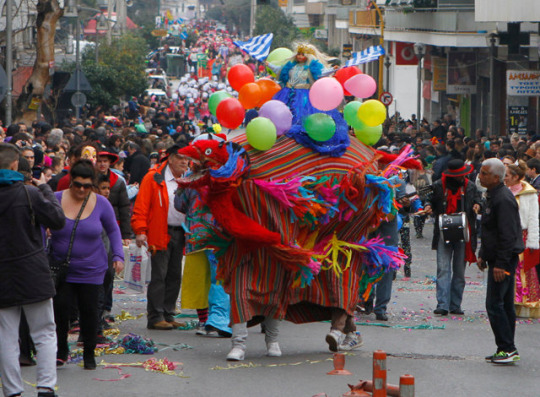
25. Random Information
Namedays are the days when the saint who has your name died. It's said that you actually take your name from them - even if it comes from your grandparents the saint is the reason you have it.
In that day you bring treats to your school or work, or you treat your friends to drinks or coffee. People give you wishes ("enjoy your name" is the most common) and they call you on the phone to wish if they are away. The most common name in Greece is Maria and in Maria’s nameday everybody has to call half of their relatives and friends to wish. It’s a bit offensive if someone doesn’t remember your nameday or if they don’t call.
We bring food to the workplace in happy events - like when your child was accepted into a university.
Lots of people cross themselves when they pass outside a church. They could be passing on foot, on the bus, or even when they drive a motorcycle.
You also cross yourself when you call god for protection or when you hear something strange (accompanied with "come Christ and Virgin Mary!")
Making embroidery with the face of Jesus and/or Virgin Mary is a thing.
40 days after the pregnancy women and their newborns can
woman can go out of the house but they have to go to Church to be blessed by a priest first.
We say "Christ!" when a person is chocked and "Small healths!" when someone is sneezing.
When a baby is yawning bad spirits could come in so we cross their mouth. We also give them eye bendants so the Evil Eye won't get to them. People spit (just saying "ftou ftou ftou") the child after saying good words for them so they can protect them from others who will flatter them with malice. The Evil Eye is recognised by the Church. See more in my #mati tag.
Bell ringing every day before the morning and evening liturgy. It also chimes every hour. On Good Friday it rings solemnly all day.
Priests are considered spiritual leaders by many in the sense they can listen to you and guide you like a psychologist. "My spiritual" people call them.
You don't have to have your mind unguarded, that's why Greek orthodoxy is against yoga which teaches the emptying of mind
Mondays and Wednesdays of all year are for fasting - just meaning you don't eat meat. Some people also fast sexually on those days.
Hatzis- (from middle eastern "hajj") is for people visiting the holy land (Israel) on pilgrimage.
The icons of saints you buy have to be blessed by the Church before you hang them, so they can offer you a connection to the divine.
Every day at school children gather in the yard and one child says the Lord’s Prayer
We don't know the hymns by heart. They are too many and long. But there are books you can read and older people (usually women) usually study them.
All the saints in hagiographies look kinda malnourished because they are supposed to avoid the earthly pleasures.
We give epithets to the saints according to their characteristics - like we did with our ancient gods.
Lots of saints probably “covered” the dominions of older deities because Greeks were used to having smaller powerful entities for different stuff (there is even a saint who helps you find stuff if you dedicate a pie to the church)
We have a set of explanations for dreams (Ονειροκρίτης). For example, if you see something very good in your sleep about a person, misfortune will find them. If you see them dying, they will live for many years.
We read the future in the bottom of the cup of Greek coffee.
From the Byzantine era and today people buy holy wood - from the cross of Christ they say - and bones of saints. In the old time those were also used for witchcraft.If you are born on a Saturday you don't see creatures or ghosts. Also people born on Saturday are lucky and whatever they wish comes true.
Dick festivals are a thing in some areas and they mostly happen on Greek Carnival. Traditional sex songs with dances are also a thing.
Virgin Mary is the mother of Greece, and you see her as a mermaid even. We are pretty chill with our divine figures - we use them in swearing a lot, too.
Many people cross themselves before and after eating.
We take oil blessed from the Church and we put it in the lamps of our home altars. We also anoint people who want to keep safe with it. (My grandma made a cross in my forehead, for example). Many take it home the myrrh produced by the bodies of saints.
We place a bone of a saint on the ground where a church is going to be built.
Sometimes we call a priest to bless our new vehicle!


Also, it’s not a very safe practice but a lot of people hand crosses and icons from their front mirror.
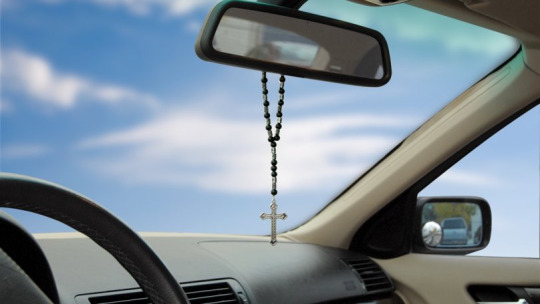
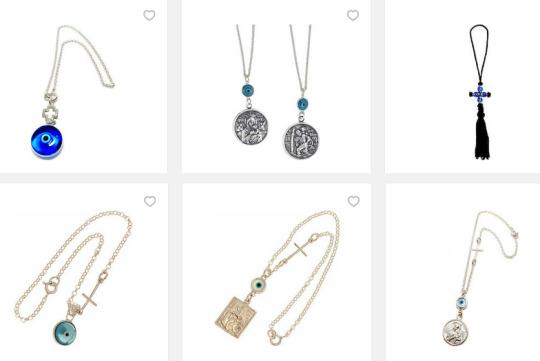
Notice that the #mati is also there!
33 notes
·
View notes
Photo
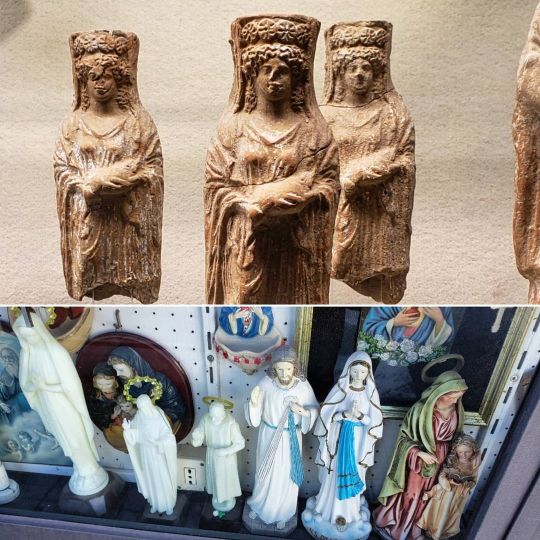
Archaeologists are very careful to identify to whom an ancient temple is dedicated until they have concrete evidence (and I don't just mean concrete in the sense of stone!). In Siracusa, for example, we know that the temple to Apollo on Ortigia is for Apollo because there is an inscription on the east-facing stairs stating it is for Apollo. In Agrigento, the renowned temple is called the "Tempio di Concordia" as a nickname because no evidence of to whom that temple was dedicated exists. In the case of the Sanctuary for Demeter and Persephone that I posted yesterday, finding thousands of terracotta votive statuettes identified the site. Votives (pictured) offered as a vow or intention to supernatural entities have been used for centuries and throughout the world. Pictured above are votives of the fertility and agricultural goddess Demeter found at Pizza della Vittoria in Siracusa during the excavations in the 1970s and 1980s. She is identified because of holding the piglet, which recalls the rites celebrated during the important Thesmophoria agricultural festival when the sacrificing of pigs is among the religious rituals practiced in her honor.) To put these ancient offerings in perspective, below are votives from today that pilgrims coming to visit the Madonna of the Tears at her sanctuary here can purchase and offer or bring home for one's personal altar. Seeing such objects side by side goes to show us that so many of our human practices have existed for millennia. #experiencesicily #sicily #siracusa #demeter #divinefeminine #sacredfeminine #votives #statuettes #orsi #sicilia #siciliabedda #italy #italia #sicilyvacation #sicilians_world #ig_sicily #igerssicilia #instasicilia #gf_italy #siculamenteDoc #sicily_tricolors #ig_visitsicily #Sicilia_PhotoGroup #smallgrouptours #traveltogether #authenticsicily #smallgrouptoursitaly #whatsicilyis #viverlasicilia #sicilytour (at Syracuse, Italy) https://www.instagram.com/p/CLeC5thl0C5/?igshid=1p8xzvja79kxv
#experiencesicily#sicily#siracusa#demeter#divinefeminine#sacredfeminine#votives#statuettes#orsi#sicilia#siciliabedda#italy#italia#sicilyvacation#sicilians_world#ig_sicily#igerssicilia#instasicilia#gf_italy#siculamentedoc#sicily_tricolors#ig_visitsicily#sicilia_photogroup#smallgrouptours#traveltogether#authenticsicily#smallgrouptoursitaly#whatsicilyis#viverlasicilia#sicilytour
5 notes
·
View notes
Photo

Phoenician Votive Figure
Circa: 600 BC to 500 BC
Dimensions: 15″ (38.1cm) high
Medium: Terracotta
Origin: Lebanon
This outstandingly beautiful and well-preserved ceramic sculpture is a votive figure from the middle of the first millennium BC, and represents a Phoenician deity. It depicts a goddess standing on an integral base, which bears an offerings bowl (partly obscured by calcareous concretions), her right hand raised and her left hand at her throat. However, it is the quality of the artistry and the almost miraculous preservation which makes this sculpture so remarkable, for most of the details that can be seen here have been eroded in other examples. The face is exceptional, carved with a serene expression and a half smile, with lidded eyes, a long nose and rounded cheeks.
Read Full Description >
85 notes
·
View notes
Photo

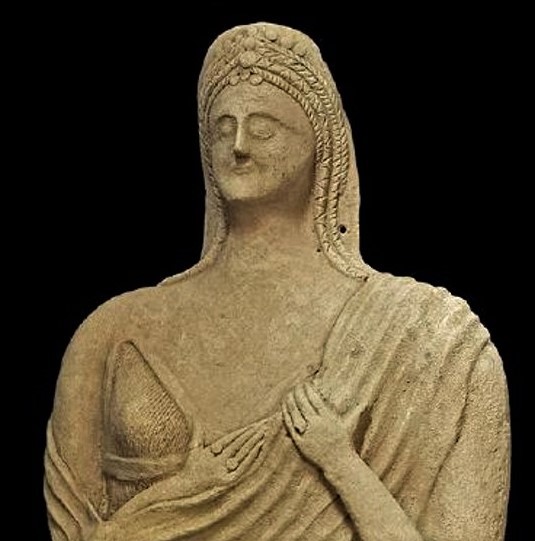
Greek Terracotta Standing Kore, 6th-5th Century BC
A hollow-formed terracotta kore with modeling to the front and sides, wearing a draped robe with pleated lower section and fold across the chest and left shoulder; ribbed and banded undergarment to the chest; elaborate braided hairstyle with pellets, finely modeled face with piercings beside the neck; hands raised to the left breast with three finger rings. 23 kg, 105cm (41 ¼")
The piece displays styles of Eastern Greek workmanship, possibly from one of the Greek islands, Cyprus, or one of the Greek colonies such as Cyrenaica, and is that of a kore (pl. korai), the name given to a type of free-standing ancient Greek sculpture of the Archaic period depicting female figures, always of a young age. They show the restrained “archaic smile”, but, unlike the nude male kouroi, the korai are depicted in thick drapery, ornate, and in painted examples very colorful. They often have elaborate braided hairstyles. There are a number of theories as to whom they represent with the most popular being that of the goddess Persephone as some are shown holding a pomegranate, a fruit associated with the goddess of the Eleusinian Mysteries.
Another theory is that they represent images of wealthy patrons and were set up in temples as offerings to the gods and to be a constant presence before the deity. Korai are found in most of the ancient cities of the Greek world, with the most famous being those from the Acropolis in Athens. Although they show a similarity in form with the arms either by the side or held up and holding a votive offering, the clothes reveal regional styles and the fashions of the elite in archaic Greek society.
473 notes
·
View notes
Photo
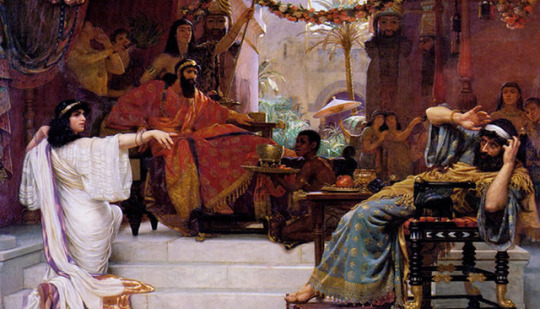
Children's Religious Stories - The Saints - Part 59
With Image:
https://www.linkedin.com/pulse/childrens-religious-stories-saints-part-59-harold-baines/?published=t
ST BERNADETTE
BERNADETTE SOUBIROUS was the daughter of a miller in the town of Lourdes. When she was born the family was quite prosperous, but the father was a ne'er-do-well, and by the time that Bernadette was thirteen they were living in a slum — a single, stone — walled room about five yards square with two small windows opening on a courtyard where there was a manure heap. "They were poorer than I can say," wrote a cousin, " — two poor beds, one on the right hand near the door, the other on the same side near the chimney; a little old box containing their linen; a few terracotta plates; and that was about all."
What was worse, the father was put in prison for a short time, and the townsmen considered the Soubirous family very unpleasant people. It did not matter that they were poor; they were the wrong kind of poor down-and-outs, who were hardly worth helping. However hard the mother tried, the slum room could not be kept free from vermin. However good the children tried to be, they were always hungry — one of Bernadette's brothers was found eating the votive candles in the church — and no one thought of them as anything but "bad stock."
One day, when she was fourteen, Bernadette went out with her sister and another girl to gather some firewood from a little copse; but a woman there told them not to trespass. There was plenty of wood, she said, washed up by the river near a rock with a little grotto in it. The children ran off to find it and, as the river was a mere trickle at one point, they took off their shoes and paddled across. But Bernadette, who had a bad cough and had been told by her mother not to get wet, did not go with them. She asked her friend, who was bigger than she was, to carry her across; but the girl would not and shouted: "You can cross as we did." In spite of her cold, Bernadette did not want to be left behind; so she took her stockings off and was just going to cross when she heard a noise like a great gust of wind and saw the bush on the rock above the grotto waving about. Behind it was something white, and Bernadette, looking closely, realized that it was a Lady.
"She had a white veil which came to her feet," said Bernadette later, when she was describing it. "I saw a yellow rose on each foot. She kept her hands slightly apart and held a rosary. She was young. Her face and clothes reminded me of a statue of Our Lady before which I used to pray, but she was alive and had light all round her. I gazed hard for a moment, then knelt down, and started praying. She smiled at me and withdrew into the biggest opening above the grotto."
When the others came back with their firewood she asked them if they had seen anything. But they had not, and Bernadette whispered to her sister what had happened. That evening, when Bernadette was saying her prayers at home, she suddenly burst out crying and was so upset that her sister told her mother what had happened during the afternoon. All her mother said was that she must have been dreaming, and the family told Bernadette not to be a silly little girl but to forget all about it.
But Bernadette could not forget. She was quite sure she had not been dreaming. She went back to the grotto, and again she saw the Lady. Other people went with her and, though they saw nothing, they realized that Bernadette was seeing and talking to some one.
Some of the people thought Bernadette was ill, some that she was a little mad; more thought it was only a trick that the unpleasant Soubirous family were trying to play on the rest of Lourdes so that they could get talked about and perhaps get some money. But however they tried to prevent it, Bernadette kept going back to the place and praying and hoping to see the Lady.
It was on February 11, 1858, that the first vision appeared. By March 4, Bernadette had seen the Lady sixteen times, and there was a crowd of twenty thousand people watching her pray there. That great crowd had come to believe her because of something that had happened on February 25. On that day, the people had seen Bernadette crawl on her knees up and down the cave, then start down to the river, then turn back again to the cave, and scrape the mud at the bottom of a dirty puddle, from which she drank and daubed her face.
After this the people of Lourdes were quite sure the little girl was mad. For they had not seen the Lady or heard her say to Bernadette: "Go and drink at the fountain, and wash yourself in it."
When Bernadette had started to go to the river to wash and drink the Lady said that that was not the spring she meant, and she pointed to a spot in the cave. All that Bernadette could see there was a dirty puddle, but she knew that she must do as the Lady told her. When the crowds asked her why she had done it she simply said: "I have no idea. The Lady told me to."
Most of the people went away in disgust; but a few stayed behind, sorry for Bernadette and wondering what would happen next. They were the few who saw the muddy puddle turn into a little stream of clear water, which bubbled up from a spring which no one had known of till the Lady pointed it out to Bernadette.
A few hours later an old stone-mason of Lourdes, hearing of the finding of this new spring, sent his daughter to bring him some of the water. He had lost the sight of one eye twenty years before. When he bathed his eye in the spring-water it was healed at once. All Lourdes soon knew of the miracle, which was the first of thousands; and today from all over the world the sick come to be cured and to pray at Our Lady's Grotto where the water flows which was discovered because of the obedience of a little slum-girl of fourteen — St Bernadette.
1 note
·
View note
Text
So my last supervision meeting led to me being sent away to “work on my methodology”. Oh.
Apparently, my methodology so far has been “yelling about weird old vases until someone stops me” and now they have.
The problem is that I’m SUPER into my topic – I literally love the subject. I have a pintrest board dedicated to her. I often sit on the bus and just think about her all the way home. I will tell anyone that will listen (including a random woman outside a Mike and the Mechanics gig last week…) EVERYTHING about the figure I’m looking at because she’s just so utterly bitchin’ awesome.
Unfortunately, enthusiasm isn’t a methodology. You can’t get a PhD in liking something the most. You have to actually have a point to it. I’ve got a massive heap of stuff I know and things I’ve read, but it’s gotten tangled and what I really need to do is figure out what the hell I’m going to do with it.
So I’ve been working on my methodology. First question: What am I trying to show with this? So far my answer has been to pull a lot of angry faces, blame J.N. Coldstream, quietly yelling at my laptop and eventually giving up and getting quite drunk.
I came to the conclusion that my topic is just too bloody huge and I need to narrow it down. My ideal topic would be “Potnia Theron: she’s bloody amazing” and would cover everything from the Neolithic to the 1970s (because if you’re not going to end a study that big with Barney Bubbles’ cover of Hawkwind’s “Space Ritual” album, what’s the point?!) Unfortunately nobody wants to read a thesis that’s a billion pages long.
So I narrowed that down. I’ve got a historic and geographical “frame” and just need to sort out the jigsaw within that.
Back to the “What am I trying to show?” question… More scowling. Occasional spaghetti breaks and a lot of singing along to Genesis. I’m no nearer an answer.
I’ve tried spider diagrams, I’ve trawled through the recommended reading my supervisors gave me, I’ve tried asking “What would Zodiac Mindwarp do?”. All with varying degrees of usefulness.
More framework – what media am I covering? Of course, literature is first out of the window because who has time for Hesiod? Vase paintings are my big big love, but, as I found out with my Masters, there aren’t a whole lot of complete ones from this period. Sculpture isn’t that big of a deal at this point in time, so it’s unlikely that’ll come up. Votive items are going to be a big deal – lead, ivory and terracotta figurines. At first I was going to use these as supplementary evidence to the vases, but if I’m going to have any kind of solid study I’m going to need them a lot more.
Good. I’ve got some material evidence. Now what am I going to show with it? Every time I come back to this question, I go into meltdown. There’s so many wonderful things I *could* do with it – there’s an apotropaic element, there’s religion there, there’s elements of the funerary realm, there’s cult, there’s art, there’s outside influence and “eastern influence” (don’t get me started on ~the near east~ - that famous singular ancient culture….) and its reception and perception – this one small class of figures opens a Pandora’s Box (nobody will get that reference – having wisely discarded the Hesiod previously) of things that I would be delighted to plunge my brain into for a good soak.
Tonight is yet another change of tack. Peter Gabriel (Especially 3/Melt), diet pepsi and blogging about the problem. I’m not sure if it helps, but I feel better about it….
0 notes
Text
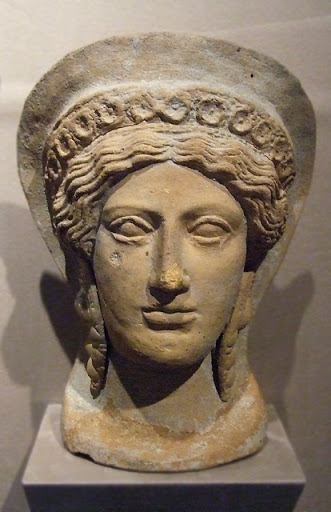
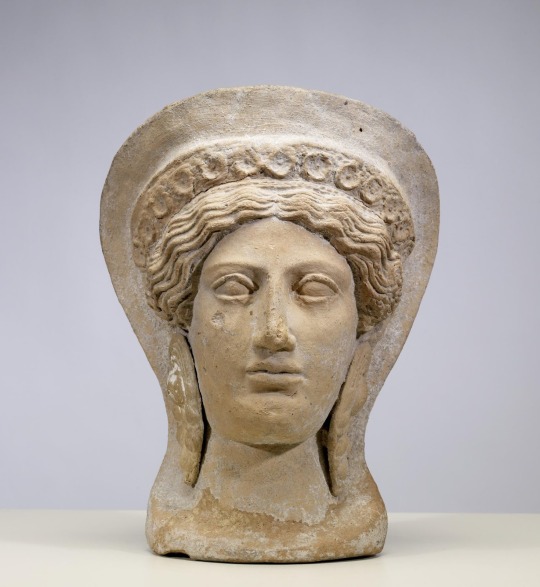
Etruscan Head of a Woman with Earrings 4th C. BCE. Terracotta. The Walters Art Museum.
"The woman depicted in this votive dedication is draped in a thick cloak and wears a diadem embellished with a row of rosettes. Her wavy hair is centrally parted and tucked neatly behind hear ears. Her eyes are a regular almond shape and her nose is long and narrow. Her features can be considered idealized as they give no indication of individuality. The only details that display a sense of individuality are the elaborate earrings she wear that were likely made separately, perhaps cast from real examples in gold. The earrings are composed of a central sphere crowned by semicircular double row of dots. From the stud hang several other spheres arranged in the shape of an inverted pyramid. Votive offerings in the form of heads are typical dedications from the Etruscan sanctuaries of central Italy and became widespread from the 4th to 3rd centuries BCE. Most votive heads are made using two molds—one for the face and one for the back of the head. The two clay halves were joined and the features were reworked with a modeling tool to create more individuality. The heads are meant to be viewed frontally, with little attention to detail paid to the back of the sculpture. Often times these heads were represented with a simple veil draped over the back of the head. The style of most Etruscan votive heads clearly demonstrates the influence of Classical Greek sculpture (480-323 BCE), a period characterized by a heightened interest in representing the ideal human form."
-taken from art.thewalters
https://paganimagevault.blogspot.com/2020/03/etruscan-head-of-woman-with-earrings.html
#etruscan#rasenna#european art#europe#pagan#antiquities#classical art#sculpture#statue#the walters#paganism#art history#art#4th century bce
14 notes
·
View notes
Text

Etruscan terracotta votive head 3rd-2nd C. BCE. German private collection. Acquired by the present owner in 1998. Hollow moulded, in the form of a female, with curling hair drawn back from her face, tresses falling down either side of neck, wearing small disc earrings, 9 7/8 in. (25 cm.) high; another, in the form of a youth, with striated hair and prominent ears, 10½ in. (27 cm.) high; another votive male head, smaller, with curling hair, 7 in. (18 cm.) high; and a fragmentary Etruscan terracotta votive left foot, 6¾ in. (17 cm.) long, all 3rd-2nd Century BCE
"Now, of those prophecies made when Torquatus and Cotta were consuls, —
Made by a Lydian diviner, by one of Etruscan extraction —
All, in the round of your crowded twelve months, were brought to fulfilment.
For high-thundering Jove, as he stood on starry Olympus,
Hurled forth his blows at the temples and monuments raised in his honour,
And on the Capitol's site he unloosed the bolts of his lightning.
Then fell the brazen image of Natta, ancient and honoured:
Vanished the tablets of laws long ago divinely enacted;
Wholly destroyed were the statues of Gods by the heat of the lightning.
Here was the Martian beast, the nurse of Roman dominion,
Suckling with life-giving dew, that issued from udders distended,
Children divinely begotten, who sprang from the loins of the War God;
Stricken by lightning she toppled to earth, bearing with her the children;
Torn from her station, she left the prints of her feet in descending..."
-Cicero, On Divination: Book 1.12
#etruscan#rasenna#european art#europe#antiquities#pagan#italy#paganism#ancient#sculpture#statue#literature#antiquity#quotes#3rd century bce#2nd century bce
11 notes
·
View notes
Text

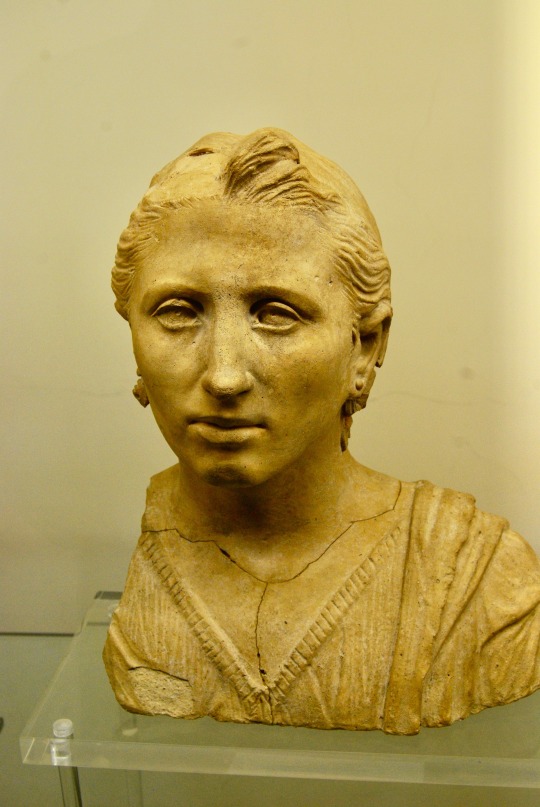
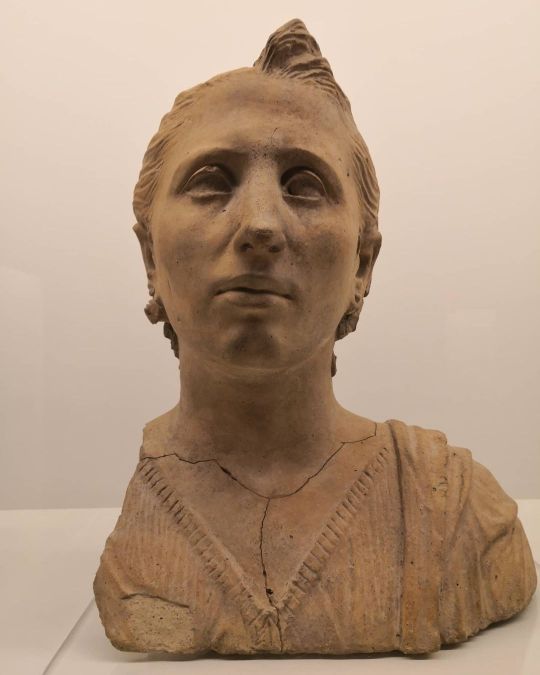
Etruscan female bust from Cerveteri 300-250 BCE. Museo Gregoriano Etrusco, Vatican Museums.
"The bust is not among the votive terracotta produced in series with matrices, but rather constitutes an original work modeled directly by a talented artist for a commission of rank. It represents a relatively young woman with well-defined physiognomic characters and a clear portraitist intent. The surface of the face and neck is very smooth, to make the complexion more radiant. The wrinkles defined on the neck and under the chin mark the passage of time on a face more absorbed than ideally detached.
The lion's head earrings, reproducing gold specimens widespread in the Etruscan and Magno-Greek area (about 325-200 BC) and the fluffy hair inspired by the portraits of Alexander the Great allow us to date it to early Hellenism.
Middle-Italian portraiture is partly indebted to the formal conquests of Greek art, which in early Hellenism elaborated the first dynastic portraits. The portrait constitutes a well-attended genre in Italic culture, adopted both in the votive and funerary ambit, which will be made by the Roman aristocracies due to the importance attached to the individual image. The genre will pass through Roman art in Western figurative culture."
-taken from museivaticani.va
https://paganimagevault.blogspot.com/2020/03/etruscan-female-bust-from-cerveteri-300.html
#etruscan#rasenna#european art#europe#antiquities#classical art#ancient art#pagan#vaticanmuseum#paganism#sculpture#art history#4th century bce#3rd century bce
10 notes
·
View notes